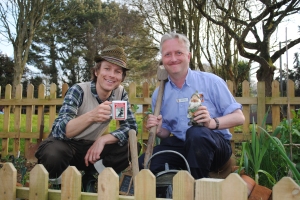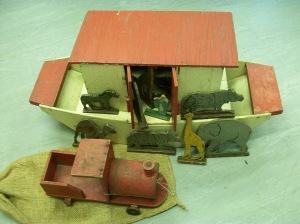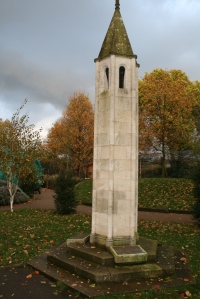“LOST IN THE GARDEN OF THE SONS OF TIME”
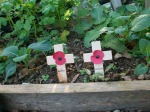
Two poppy crosses in memory of zoo staff of all nations lost or injured worldwide in 1914-18 and 1939-45 amongst the growing food plants of the World War Zoo gardens, Newquay Zoo
November 2013 and March 2014: please see the updated information on ZSL London Zoo casualties from WW1 from this blog post which has been updated with new research
NOVEMBER
is always a bit of a solemn month for me in the garden with the darker days earlier, the lost hour of summer time, leaves fallen; it is also Remembrance Sunday, poppies and Armistice Day.

One of many overwhelming lists of names in stone. Arras Memorial to the missing with no known graves from the Arras offensive of 1917 and (foreground) CWGC individual graves Image: cwgc.org
At Newquay Zoo, there is one of the noisier two minutes silence in the nation if the maroon bangs go off at 11 o’clock in Newquay, as this sets off all the zoo animals calling out.
At London Zoo, at memorials and churches all over Britain and Europe, people will stop and gather, think and reflect on the extraordinary, almost incomprehensible loss of life in wartime which affected so many walks of life including zoos and botanic gardens.

Belle Vue zoo’s sadly vandalised war memorial, Gorton Cemetery. Manchester lists their First World War dead – a tiny glimpse of the losses of men from zoos on active service in both world wars. Image: manchesterhistory.net
Heligan Gardens http://www.heligan.com/
near Mevagissey in Cornwall, only about twenty miles from Newquay Zoo, is a garden restoration unlike many others I have visited, as it is haunted by the loss of the generation of garden and estate staff. They left their names under the penciled graffiti “Come not here to sleep nor slumber” in the “Thunderbox”, the primitive bothy toilet for estate staff. Many of these staff did not survive their service in the First World War in mind or body. The estate and garden without its usual labour force, as the Heligan staff today simply describe it, “quietly went to sleep” until the story was uncovered along with the overgrown gardens in the early 1990s. A beautiful little book tracing the staff named and signed in pencil on that wall and on the estate books has recently been published The Lost Gardens of Heligan – Heligan History: Lost Gardens, Lost Gardeners, being a Commemorative Album of Heligan through the Twentieth Century, featuring the Tremayne archive and the stories of staff who were lost in the Great War (published by Heligan Gardens Ltd and available on their online shop for about £3.95)

A small memorial at Newquay Zoo to the many zoo keepers, families and visitors worldwide who have been affected by wartime since 1914 (Image: World War Zoo gardens project, Newquay Zoo)
Zoos, aquariums and botanic gardens suffered similar losses of staff, as poignant as the effect on estates like Heligan or large organisations like the Great Western Railway (West country stations like Exeter still have the long list of the dead on their platform walls).
Few records survive for zoos, I have so far frustratingly found. I have been researching the wartime effects on a few typical British zoos operational in the First world war and what that generation learnt in preparation for surviving the Second world war (when our wartime dig for victory garden project at Newquay Zoo is set) for a forthcoming article in The Bartlett Society Journal www.zoohistory.co.uk The few records so far can stand in for a whole generation and zoos across the world.
On Armistice Day Thursday 11th and on Remembrance Sunday 14th, spare a thought for the keepers and zoo staff remembered on the ZSL war memorial at London Zoo. 12 names are listed from the staff out of 54 who served in the forces or munitions work in the First World War out of a staff of 150.
Poppies will be laid at the ZSL War Memorial, a Portland Stone memorial designed by architect John James Joass in 1919, based on a medieval Lanterne des Morts memorial to the dead at La Souterraine, Creuse Valley, France. The memorial was moved from the main gate area in 1952 after the 1939-45 names were added and is now near to the Three Island Pond area.
Reading the names means these men are not forgotten.
Read the names and spare a thought for these lost zoo staff from both wars.
Researching and reading a few of these background stories puts a more personal face on the scale of the losses, especially in the First World War. I shall feature a few more of these stories over the next year as information is discovered. The impatient reader can check the www.cwgc.org site. Many thanks to Kate Oliver at ZSL who transcribed or guessed the names on the very well polished brass name plates.
strong>November 2013 and March 2014: please see the updated information on ZSL London Zoo casualties from WW1 from this blog post which has been updated with new research.
ZSL London Zoo war memorial
The Zoological Society of London
In memory of employees who were killed on active service in the Great War 1914-1919
29.9.1915 Henry D Munro 4 Middlesex Regt ZSL Keeper (Transcribed details on this need to be checked)
18.03.1916 William Bodman (Buffs) 6th Btn, East Kent Regt, Private ZSL Helper. Age unknown. Commemorated on the Loos Memorial, no known grave.
10.07.1916 Albert A Dermott 13th Btn. Rifle Brigade, Rifleman ZSL Messenger, aged 22, killed on Somme, no known grave, listed on Thiepval Memorial
15.9.1916 Arthur G Whybrow 2547, 19 Bn. County of London Regt , ZSL Helper. Killed aged 23 during Somme battles, probably in the clearance of High Wood by 47 (London) Division, 15 September 1916. Individual grave at London cemetery, Longueval. Married.
05.10.1916 Gerald P Patterson 19 County of London Regt ZSL Helper (Transcribed Regiment details on this need to be checked)Probably Private G P Patterson of the 8th Battalion, Norfolk Regiment was killed on 5th October 1916, no age given, during the Somme fighting. Individual grave. Buried in Connaught Cemetery, Thiepval, Somme, France.
23.10.1916 William Dexter Kings Royal Rifles, Rifleman ZSL Keeper2nd Battalion, Rifle Brigade. Aged 31. Individual grave at Bienvillers Cemetery. Married.
09.04.1917 Robert Jones 9 Royal Fusiliers ZSL Gardener
Two possibilities exist for this casualty, firstly Private GS/60595 Robert Jones, 9th Battalion Royal Fusiliers was born in Islington or Highgate, Middlesex around 1881. He was married to Bertha Lewin of Abbots Ripton, Huntingdon around 1905 / 1906 in Camden / Highgate. He was formerly listed as 23358 6 Middlesex Regiment, having enlisted in Harringay and been resident in Highgate. On the 1901 census he is listed as a Gardener (not domestic) and in 1911 as a Nursery Gardener. On the CWGC website he is listed as the husband of Bertha Jones of 22 Caxton Street, Little Bowden, Market Harborough. This Robert Jones died of wounds on 7 April 1917 (two days different from the ZSL dates on the war memorial plaque) and is buried in Faubourg D’Amiens cemetery in Arras.
The second possibility is 472712, 1st / 12th Btn. London Regiment (The Rangers), aged 31. Individual grave, Gouy-en Artois Cemetery, killed first day of the Battle of Arras 1917. Listed on the 1911 census as a coal porter gas works, rather than a gardener. Hopefully the ZSL staff records will help to determine the correct Robert Jones. Both casualties deserve to be remembered.
21.4.1917 Henry George Jesse Peavot Honourable Artillery Co ZSL Librarian B Co. 1st Btn, aged 35. Killed during Battle of Arras period, No known grave, listed on Arras Memorial. Married.
23.9.1917 Albert Staniford Royal Field / Garrison Artillery ZSL Gardener 174234 216 Siege Battery. RGA Individual grave, Maroc British cemetery, Greany, France. Period of Third Battle of Ypres / Passchendaele, July to November 1917
03.10.1917 William Perkins Royal Garrison Artillery ZSL Keeper 115806, Bombardier, 233rd Siege Battery. Buried in individual plot, Belagin Battery Corner Cemetery, Belgium. Aged 39. Married.
29.11.1917 Alfred? L? Day 2 Rifle Brigade ZSL Helper
At first sight 19.1.1918 may apprar to be a wrong date transcribed on a well polished brass plate; the most likely casualty for this name is Alfred Lomas Day, S/20305 2nd Bn, Rifle Brigade, killed 29 November 1917 and buried in an individual grave (1841) Rethel French National Cemetery, Ardennes, France. However March 2014 research on ZSL staff record cards suggests that this casualty may be an R Day or Richard Day who died on 19 January 1918 as a German POW. Further research is required to find out if this man is the same or different from Alfred L Day.
10.9.1918 Charles William Dare County of London Regt Helper, 245116, London Regt (Royal Fusiliers), Vis-en-Artois memorial, no known grave. Killed during period of the “Adavnce to Victory” (August to November Armistice 1918)
“TILL THE RED WAR GLEAM LIKE A DIM RED ROSE / LOST IN THE GARDEN OF THE SONS OF TIME” memorial verse
Zoological Society of London
In memory of employees killed by enemy action during the war 1939-45
Regent’s Park
Davies. Henry Peris (Lieutenant RA) ZSL Clerk: Killed in action Far East 21.12.1941 164971, Royal Artillery, 5th Field Regt, died aged 27. Listed on the Singapore memorial.
Leney. William Walter Thomas ZSL Overseer: Killed by flying bomb 25.11.1944
Peachey. Leonard James (Sergeant RAF) ZSL Clerk: Killed in air crash Lincs 18.12.1940
Wells. Albert Henry (Gunner RA) ZSL Keeper: Killed in action, Burma 25.01.1945 Gunner 1755068, Royal Artillery, 70 H.A.A Regiment
Whipsnade Park
Adams. Percy Murray (Gunner RA) ZSL Keeper: Died in Japan POW 28.07.1943 Gunner 922398, Royal Artillery, 148 (Bedfordhsire Yeomanry) Field Regt, died aged 26.

Percy Adams, ZSL Whipsnade keeper who died as a Japanese POW is buried here at THANBYUZAYAT WAR CEMETERY, Image: http://www.cwgc.org
Checking with the excellent Commonwealth War Graves Commission records site http://www.cwgc.org under ‘search for a casualty’ shows that Albert Henry Wells is buried in the Taukkyan War Cemetery in Myanmar (Burma). Percy Adams in Thanbyuzayat War Cemetery, Myanmar / Thai border. The CWGC website notes of this cemetery: “The notorious Burma-Siam railway, built by Commonwealth, Dutch and American prisoners of war, was a Japanese project driven by the need for improved communications to support the large Japanese army in Burma. During its construction, approximately 13,000 prisoners of war died and were buried along the railway. Thanbyuzayat War Cemetery was created [postwar] by the Army Graves Service who transferred to it all graves along the northern section of the railway, between Moulmein and Nieke.”
ZSL Clerk Leonard Peachey, RAF Volunteer Reserve, died aged 32 as Sergeant Wireless Operator / Air Gunner in an air training crash serving with 22 Squadron in Lincolnshire at RAF North Coates / Cotes. He is buried in North Cotes (St. Nicholas) Churchyard, Lincs alongside what are presumably his crew from 22 Squadron, killed on the same day: Sergeant Pilot Dennis George How RAFVR (aged 23) and Sergeant Observer Paul Victor Renai (aged 22, from Wellington, New Zealand) and Sergeant Wireless Operator / W.E. Mechanic Ralph Gerald Hart (22). 22 Squadron brought the Bristol Beaufort into operational service http://www.rafmuseum.org.uk/london/collections/aircraft/bristol-beaufort.cfm; receiving the first aircraft in November 1939 and, after an intense work up at North Coates in Lincolnshire, the Squadron resumed operations in April 1940, beginning with mine-laying sorties. It moved to RAF Thorney Island where torpedo operations were resumed in August. In order to cover a wider area of sea the Squadron sent out detachments, to RAF Abbotsinch then to St Eval, Newquay in Cornwall being the most regular posting. 22 Squadron was re-formed at Thorney Island in 1955 as a Search and Rescue Helicopter Squadron. Information from http://www.22squadronassociation.org.uk/Hist1546.html

Leonard Peachey, ZSL Clerk is buried among these RAF graves at North Coates (St Nicholas) Churchyard, Lincs. Image: cwgc.org
William Leney at 65, old enough to have served in the First World war, was killed alongside his wife Kate Jane Leney (also 65) at 59 King Henry’s Road (Hampstead, Metropolitan Borough) by flying bomb. Several flying bombs are recorded as having fallen around the London Zoo area, close neighbour of RAF Regent’s Park.
Kate Oliver of ZSL London Zoo’s current education team kindly transcribed the well polished names. She thinks that Helpers were young staff who had not attained keeper rank, something I will be following up in researching their backgrounds through the census, National Archives, London Zoo archive and National Archives. .
I am interested in hearing from anyone who has further information about these men or of other wartime zoo, aquarium or botanic garden related gravestones or rolls of honour. I can be contacted at Newquay Zoo.
Belle Vue Zoological Gardens, Manchester, war memorial stories
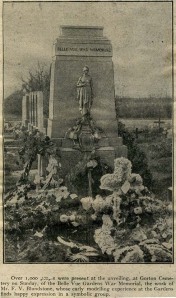
Belle Vue’s war memorial, Gorton Cemetery, Manchester on its unveiling 1926. Image: manchesterhistory.net
The only other well documented zoo one is for Belle Vue Zoological Gardens, Manchester at Gorton cemetery in Manchester, now sadly much vandalized. Much has been written about this early zoo and leisure gardens collection, which survived from the 1830s to 1977/8.
Spare a thought for the men listed on the monument, and their families. To read more of their stories, Stephen and Susan Cocks have follwed up information in the book The Belle Vue Monument (or Memorial)- with information on the cwgc.org website and others for the blog entry at http://blog.guidedbattlefieldtours.co.uk/2010/01/15/hello-world
More about the memorial, press articles from its dedication in 1926 and its current vandalized state can be found at http://manchesterhistory.net/bellevue/warmemorial.html and more from Stephen Cocks at http://blog.guidedbattlefieldtours.co.uk/2010/02/04/the-belle-vue-memorial-the-story-of-the-memorial
Belle Vue Zoological Gardens staff killed on active service 1915-1918
1915 deaths
Private Henry Mulroy, 12th Battalion. Manchester Regiment, killed Ypres, 16 August 1915. Buried Ridge Wood Military cemetery.
Private Frederick Lester Reid, 1st Battalion, Loyal North Lancs Regt, died aged 31, 25 September 1915, battle of Loos, no known grave, listed Loos Memorial. Married.
1916 deaths
Private William Morrey, died 27 June, 1916, Manchester Regiment / 1st Battalion, Special Brigade, Royal Engineers (probably a gas unit), buried Beauval cemetery, France. (Several William Morreys from the Cheshire, Lancashire and Manchester area are listed on the cwgc.org site, obviously a local name).
Private Alfred Routledge, 11th Battalion, Manchester Regiment, killed on The Somme, aged 23, 26 September 1916. Married. Listed on the Thiepval memorial, no known grave.
Routledge is one of the many “Missing of the Somme” (in Geoff Dyer’s words), killed in the final days of taking Thiepval village, one of the original objectives of the 1st July 1916, the first disastreous day of the Battle of The Somme two months earlier.
1917 deaths
Second Lieutenant James Leonard Jennison, 15th, Battalion West Yorks Regt (Leeds Pals) killed Arras, 3 May 1917 – no known grave, listed Arras Memorial. Son of James, one of the two Jennison brothers who owned Belle Vue zoo. His father James died later that year, possibly as a result of this loss. His cousin Norman, son of Angelo Jennison, also died on active service.
Private Ralph William Stamp, 18th battalion, Manchester Regiment, died aged 23, 23 April 1917, no known grave, listed on the Arras memorial, the same as J L Jennison.
Sergeant John E Oliver, 21st Battalion, Manchester Regiment, killed 24 October 1917, Passchendaele battles, no known grave, listed Tyne Cot memorial. Married.
Stoker First Class T J Tumbs, aged 40, killed HMS Drake, 2 October, 1917, convoy duty off coast of Ireland in U79 U-boat torpedo attack.
Private Harold? Heathcote, 5th Battalion, Wiltshire Regiment died in Mesopotamia (modern Iraq), 19 October 1917, buried Baghdad war cemetery.
1918 deaths
Sergeant J Fuller, Devonshire Regiment / Pioneer Corps, died 14 April 1918. Buried Amiens, France. Married
Private James G Craythorne, 1/6 Manchester Regiment, killed 20 October 1918 ironically in the fighting for Belle Vue Farm, buried at Belle Vue (Farm) Cemetery, France. (Three or four generations of the Craythorne family worked as small mammal and reptile keepers at Belle Vue, including James Craythorne who follwed his own father into zoo work, was employed aged 12 from the 1880s to retirement in 1944, replaced then by his son Albert!
Private Sidney Turner, Welsh Regiment, died aged 18, Welsh Regiment, buried in Gorton Cemetery (site of the Belle Vue Zoo war memorial). Several others who died after the war are also individually buried here.
Captain Norman L Jennison, MC (Military Cross) , 6th Manchester Regt (territorials), died of flu, Genoa, Italy 30 October 1918 serving with a trench mortar battery. Son of Angelo, one of the two Jennison brothers who owned Belle Vue zoo. His cousin James Leonard also died on active service.
Belle Vue Zoological Gardens staff died from the effect of war after 1918.

Zoo owner Angelo Jennison unveiling in 1926 the Belle Vue memorial in Gorton Cemetery to his son, nephew and zoo staff lost in the First World War. Image: manchesterhistory.net
This unusual addition gives a little glimpse of what must have happened to many zoo, aquarium and botanic garden staff who never recovered from the effects of active service in wartime.
Private WM Wheatcroft, 3rd Battalion, Kings Liverpool Regiment, died aged 28, 10 July 1919, buried in Gorton cemetery.
Sergeant Robert Hawthorne, died 24 June 1922, buried in Gorton cemetery.
Rifleman / Lance Corporal William Croasdale, Belle Vue’s baker, served Army Service Corps (bakery) and Kings Royal Rifle Corps, served overseas 1915 to 1919, aged 32, died 1922, (possibly Stephen Cocks suggests in a mental hospital, Prestwich but others have disputed this).
Private Joseph Cummings, died 9 May 1926.
First Class PO Matthew James Walton DSM, fought Battle of the Falklands naval action, 1914, died 1926.
Private Bernard A Hastain (name almost unreadable) Rifle Brigade, formerly a scene painter at Drury Lane and Belle Vue for their Firework spectaculars, died of effects probably of gas, 1933.
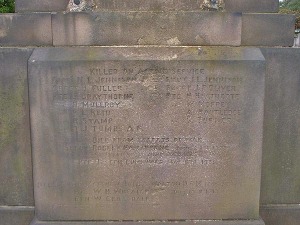
Belle Vue Zoo’s now vandalised war memorial – luckily the names, although hard to read, are inscribed in stone as the brass statue has been stolen. Image: manchesterhistory.net
Tracing service men who died after service is more difficult, not registered on the CWGC site and one for future research in the National Archives medal and pensions records (the ‘burnt documents’) if they have survived.
There are sadly many more names to add to these wartime casualty lists from zoos, botanic gardens and aquariums as our World War Zoo gardens research project continues. We would be interested to hear of any more names or memorials you know of.
mark.norris@newquayzoo.org.uk
So buy a poppy (there’s a box in the Newquay Zoo office if you’re visiting) and spare a thought for these men and their families on Remembrance Sunday, and also for the many people not listed who were affected by their war service, men and women not just from Britain but all over the world.

Afternoon autumn light on the poppies, plants and sandbags of the wartime zoo keeper’s garden at Newquay Zoo
And then enjoy the noisy peace of the zoo gardens or wherever you find yourself …

